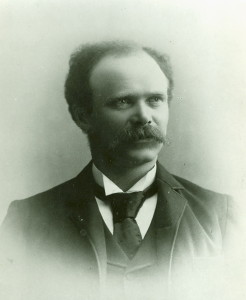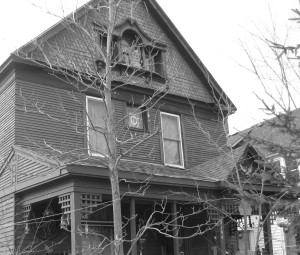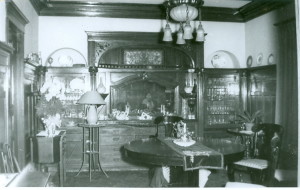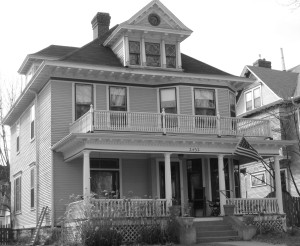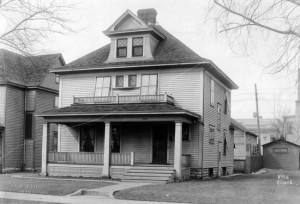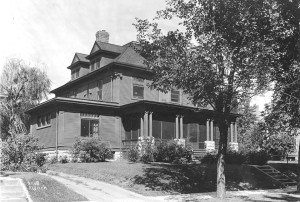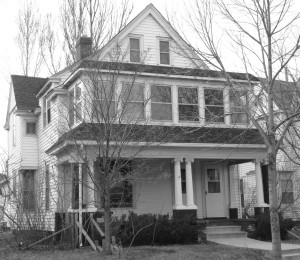
Welcome to the
Healy Project
Join us on Facebook
Send us an Email
More Hauntings: Houses Built by Henry Ingham
Henry Ingham was a master builder contemporary with T.P. Healy. Originally from Knaresborough, Yorkshire, Ingham arrived in Minneapolis armed with royal certification as a master carpenter. He began building two years before Healy, in 1884, and was active until 1933. To date, researchers have found 144 structures with Ingham’s name on the building permits (similar to Healy’s output). Along with fellow Englishman Henry Parsons, Ingham and Healy make up the “Big Three” of Minneapolis master builders. Unlike Healy, Ingham is known primarily not for his design skills, but for his exquisite craftsmanship as a carpenter. One of his houses has built-in hardwood cabinets and drawers in every closet, including those used by the servants.
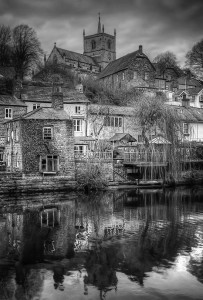
Knaresborough, Yorkshire. As you can see, this town would offer a lot more opportunities for a mason than for a carpenter.
It should come as no surprise that I’ve heard stories about haunted Ingham houses. Here are a few I’ve collected over the years:
Occupants of a house built by Ingham and used as a mixed-use office/residence told stories of footsteps sounding in the halls and staircase at night, and lights in the kitchen going off and on when no one was in the room. One resident, “Doug,” said that he had heard the back door open and shut several times in the middle of the night, but when he went out to investigate, no one was inside or outside. None of the tenants much liked going into a dark, small room off the kitchen, and they used it solely as a storage area. Formerly a rooming house and previous to that, a boarding house, the house has had many residents over the years. Apparently at least one of the departed former tenants has chosen to hang around.
Several blocks away is a single-family Ingham house that has had at least one revenant put in an appearance or two. The family w ho lived there in the ’70s and ’80s told me a number of stories about their paranormal experiences at the house. When “Karen” and “Dave” moved in, even though they liked the house, they frequently got the feeling that the house wasn’t completely theirs, as if someone else’s presence still persisted in certain rooms. One night Karen and a friend came to the house, entering through the back door. The rest of the family wasn’t at home, and for a while the two women puttered around in the kitchen, reluctant to leave it. Finally, the friend remarked, “Don’t you feel like running through the house, looking under the beds?” The friends shared a laugh, but then both admitted that they strongly felt a presence in the house and were not eager to leave the kitchen. After a while, this feeling passed, and they ventured into the parlor without incident.
The couple’s daughter, who was three at the time they moved in, quickly acquired the unorthodox habit of leaving her room in the middle of the night to sleep in the hallway. She continued this practice two or three times a week for several years, yet could not explain why she felt the need to leave her room. One night, Karen decided to sleep in the daughter’s room and see what, if anything, would happen. She was awakened by the disturbing impression of hearing a hell-and-brimstone sermon delivered by a male voice. The disembodied voice, like that of a sidewalk evangelist, harangued an invisible audience about sin and perdition.
“Dave” also had a curious experience. He was working in the backyard when a strange old man carrying a violin case appeared at the gate. Pointing to the window of their son’s bedroom at the back of the house, the man said that he had lived in that room for nearly 25 years. He had stopped by because he had recently been having recurring dreams about being in the house. He did not know why this was happening, only that it had become a regular, unsettling occurrence.
Their son had an encounter with the ghost, but only once. As he was coming out of his room one morning, he saw a misty figure emerge from the bathroom, turn to look at him, and disappear into his sister’s room. The apparition was that of a middle-aged man, his mousy brown hair wet as though he had just washed it. Was this ghost and the unseen hellfire evangelist one and the same? They never did find out.
Across town multiple residents of another Ingham house have felt the presence of the ghost of a little boy. “Mike” lived in the large house for a while. Many years before he moved in, a mother and her two-year-old son were brutally murdered in an arson fire in the house next door. Mike knew this but his partner “Ron” did not. Therefore, Mike was surprised when Ron told him that he frequently felt the presence of a small boy, but Ron never actually saw the child. Mike was pretty freaked out when Ron said that the boy would often crawl under their bed.
After Mike and Ron moved out, their friend “Jon” rented the house. Jon, like Ron, knew nothing of the fire that had killed the woman and boy. He worked out of the house as a massage therapist. One woman client, after coming back for several sessions in the house, asked Jon if he was aware that the house was haunted. He said that he did not and asked her who the ghost was. “A little boy,” she replied.
Mike had another strange experience with the house. Mike and Ron brought their cat Midnight with them when they moved into the house on Halloween a decade ago (a foreshadowing of paranormal developments?). However, when they moved out, the cat refused to leave with them. He would run away from their new place and go back to the Ingham house. Their friend Jon, a cat lover with a cat named Tom, was now occupying the house. They assumed that Midnight just liked Jon and Tom better than he did Mike and Ron. But a while later, Jon and Tom moved out of the Ingham house and moved in with Mike and Ron, leaving the house vacant.
Nobody lived at their former home, and nobody was there to take care of Midnight. Yet the cat continued to run away and go back to that house. Midnight had lived many places. He had not lived in the house for very long, so what was his attachment to the place? As Mike was friends with the owner and had keys, he finally just let Midnight into the vacant house and would go over to feed him. Midnight now had the Ingham house all to himself. But why did he want to live in this large, empty house alone? After Mike told a friend about the cat’s puzzling behavior, she replied, “Well, maybe Midnight is not alone in that house.” This suggestion gave Mike goosebumps. He now believes that Midnight has become the little boy ghost’s cat. Midnight still lives there to this day with the current residents–including the child’s spirit?
The last story involves an Ingham house that was wrecked to put in Mueller Park in the Wedge neighborhood. One of the tenants, “Jen,” who occupied the upper unit just prior to the house’s demolition told me that she heard inexplicable footfalls. On several occasions, sometimes at night, sometimes during the day, she heard what sounded like someone walking up the staircase to the second floor. When she looked out into the stairwell, no one was there. Her roommate also reported hearing the footsteps, too, when he was alone in the apartment. Jen also occasionally felt like she was not alone in the apartment, although she could see or hear nothing out of the ordinary.
I’ve kept the other addresses anonymous because these days homeowners fear would-be ghost investigators showing up on their doorsteps more than they fear being made fun of for telling such stories. However, since this house is gone and no building replaced it, I can give the address: 2510 Bryant Ave. S., built 1898. At midnight on Halloween, perhaps you’d like to venture over to Mueller Park to where the house once stood and listen for ghostly footsteps ascending a ghostly staircase. Or perhaps it’s best just to sit at home and raise a toast to the spirits and wonder. . ..
- Yesterday upon the stair
- I met a man who wasn’t there
- He wasn’t there again today
- I wish, I wish he’d go away
- When I came home last night at three
- The man was waiting there for me
- But when I looked around the hall
- I couldn’t see him there at all!
- –from “Antigonish” by William Hughes Mearns 1899
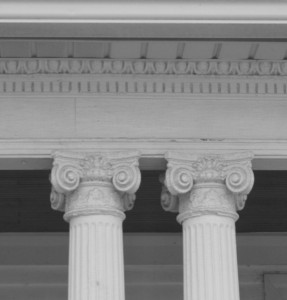
Close-up of the Ionic columns, with cornice, capital, architrave, and frieze supporting the porch roof of Ingham’s family home.
I’ve collected dozens and dozens of ghost stories since my first article, “Enter Ghost”, was published in the Wedge neighborhood newspaper in October of 1978. I’ve collected stories of haunted houses, museums, hospitals, ships, highways, barns, churches, schools, theaters–you name it. If you have a story you’d like to share, please contact me at info@healyproject.org. I’d love to hear about your experience.
–T.B.
